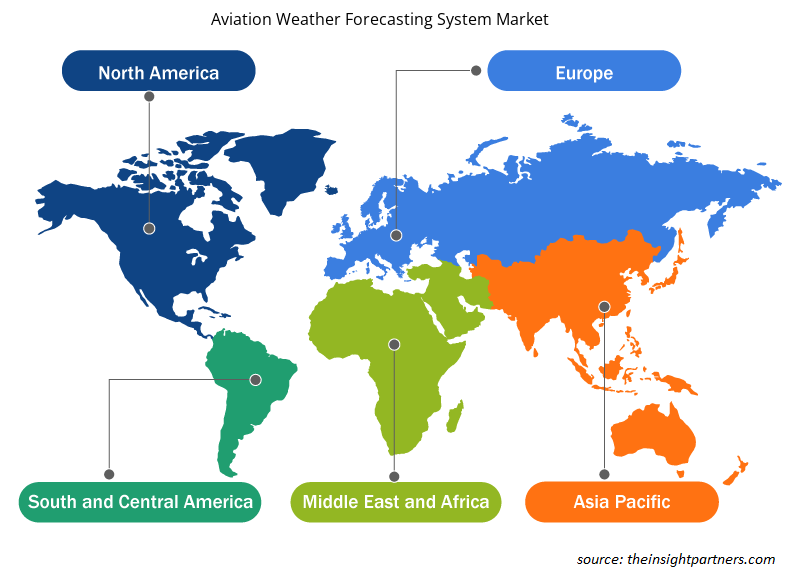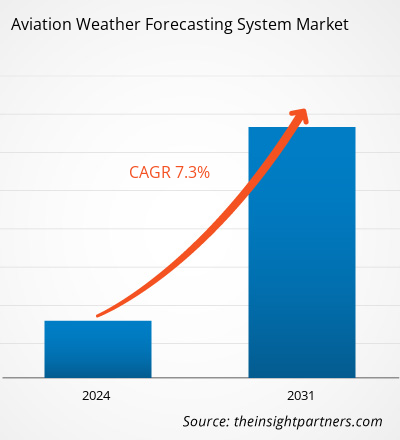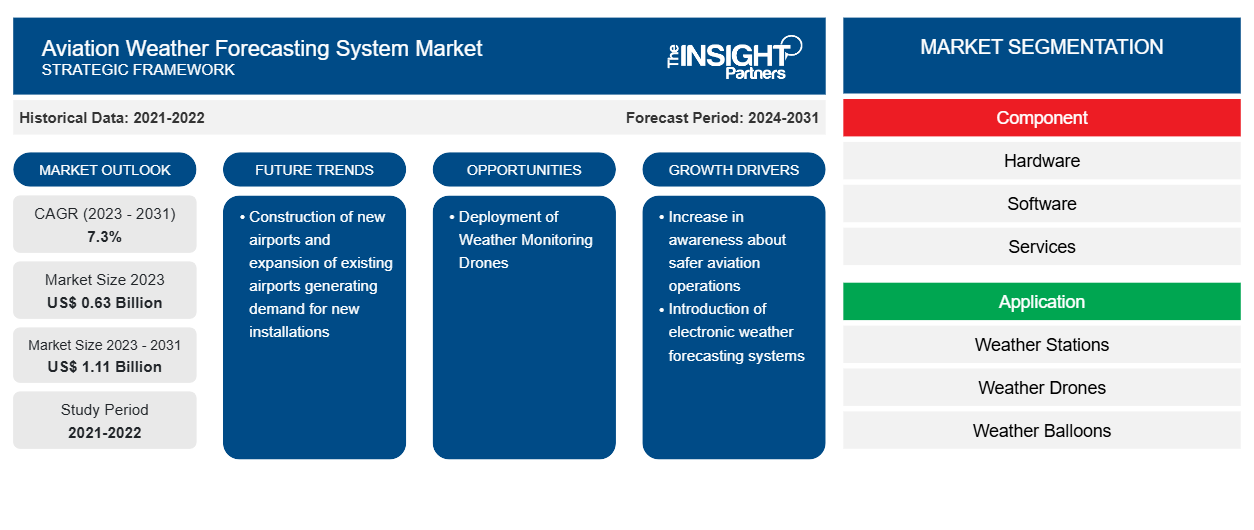Se prevé que el tamaño del mercado de sistemas de pronóstico meteorológico para la aviación alcance los 1110 millones de dólares estadounidenses en 2031, frente a los 630 millones de dólares estadounidenses en 2023. Se espera que el mercado registre una CAGR del 7,3 % durante el período 2023-2031. Es probable que la construcción de nuevos aeropuertos y la expansión de los aeropuertos existentes, que generan demanda de nuevas instalaciones, sigan siendo una tendencia clave en el mercado.
Análisis del mercado de sistemas de previsión meteorológica para la aviación
Algunos de los actores clave que operan en el mercado global de sistemas de pronóstico meteorológico para la aviación son Collins Aerospace, ENAV SpA, IBM Corporation, Vaisala y Campbell Scientific Inc. El mercado está altamente consolidado con varios actores destacados que atienden la demanda nacional e internacional. Estos actores adquieren acumulativamente una mayor participación en el mercado global de sistemas de pronóstico meteorológico para la aviación en comparación con las otras empresas, según el estudio de investigación de mercado de sistemas de pronóstico meteorológico para la aviación.
Descripción general del mercado de sistemas de pronóstico meteorológico para aviación
Los actores del sistema de pronóstico meteorológico de aviación incluyen tanto fabricantes de hardware como proveedores de software que dependen entre sí. Los fabricantes de hardware y proveedores de software son Collins Aerospace, IBM Corporation, Campbell Scientific Inc, Sutron, DTN, Spire Global, Universal Weather and Aviation Inc, Vaisala, Ubimet y muchos más. El mercado de sistemas de pronóstico meteorológico de aviación tiene muchos actores pequeños involucrados en el negocio que tienen una parte significativa del mercado global. Los actores pequeños también están involucrados en actividades de I + D para desarrollar las nuevas tecnologías que están fortaleciendo aún más el tamaño del mercado en los próximos años. Estas organizaciones a lo largo de los años han aumentado su inversión en el desarrollo de sistemas de pronóstico meteorológico de aviación nuevos y avanzados según las crecientes necesidades de los clientes con la ayuda de los organismos reguladores gubernamentales. El organismo regulador gubernamental ayuda al sistema de pronóstico meteorológico de aviación tanto a los fabricantes de hardware como a los proveedores de software al proporcionar el contrato al aeropuerto militar y a los aeropuertos comerciales.
Personalice este informe según sus necesidades
Obtendrá personalización en cualquier informe, sin cargo, incluidas partes de este informe o análisis a nivel de país, paquete de datos de Excel, así como también grandes ofertas y descuentos para empresas emergentes y universidades.
-
Obtenga las principales tendencias clave del mercado de este informe.Esta muestra GRATUITA incluirá análisis de datos, desde tendencias del mercado hasta estimaciones y pronósticos.
Factores impulsores y oportunidades del mercado de sistemas de pronóstico meteorológico para aviación
Introducción de sistemas electrónicos de predicción meteorológica
La introducción y adopción de sistemas electrónicos relacionados con la previsión meteorológica está impulsando a los proveedores del mercado a desarrollar productos innovadores y satisfacer la creciente demanda. Además, varios aeropuertos están tomando iniciativas para instalar sistemas electrónicos de monitoreo meteorológico en sus pistas y en las instalaciones del aeropuerto para lograr operaciones más seguras en todas las instalaciones. Por ejemplo, en enero de 2024, el Aeropuerto de Salida-Harriet Alexander Field (KANK) en Colorado anunció la apertura y el funcionamiento de su nuevo sistema meteorológico electrónico de última generación que les permite realizar operaciones de aterrizaje de manera más segura en el aeropuerto y tener una mejor idea de las condiciones del aire en el aeropuerto.
Despliegue de drones para monitoreo meteorológico
Los drones meteorológicos están diseñados específicamente para volar en la capa más baja de la atmósfera terrestre (la capa límite) y están equipados con sensores para recopilar información sobre la temperatura, el viento, la humedad, las tormentas eléctricas y la presión del aire en la atmósfera. El despliegue de drones para recopilar datos meteorológicos es uno de los principales factores que se espera que genere enormes oportunidades para los proveedores del mercado durante el período de pronóstico. Estos drones están instalados con sensores termodinámicos que recopilan datos meteorológicos como la humedad, la presión y la temperatura y los informan a las estaciones meteorológicas. Los sistemas de pronóstico en tiempo real pueden utilizar estos datos en los aeropuertos. El sistema de pronóstico en tiempo real luego usa los datos para proporcionar pronósticos meteorológicos y actualizaciones para entornos de tráfico aéreo. Varias organizaciones están trabajando actualmente en sistemas de recopilación de datos de drones más eficientes para lograr sistemas de monitoreo meteorológico de drones más confiables que se puedan utilizar para brindar datos más precisos y en tiempo real para los sistemas de pronóstico meteorológico en toda la industria de la aviación.
Análisis de segmentación del informe de mercado del sistema de pronóstico meteorológico de aviación
Los segmentos clave que contribuyeron a la derivación del análisis del mercado del sistema de pronóstico meteorológico de aviación son el componente, la aplicación y el tipo de pronóstico.
- Según los componentes, el mercado de sistemas de pronóstico meteorológico para aviación se segmenta en hardware, software y servicios. El segmento de hardware tuvo una mayor participación de mercado en 2023.
- Según la aplicación, el mercado de sistemas de pronóstico meteorológico para aviación se segmenta en estaciones meteorológicas, drones meteorológicos, globos meteorológicos y otros. El segmento de estaciones meteorológicas tuvo una mayor participación de mercado en 2023.
- Según el tipo de pronóstico, el mercado de sistemas de pronóstico meteorológico para aviación se segmenta en corto alcance, mediano alcance, alcance extendido y largo alcance. El segmento de corto alcance tuvo una mayor participación de mercado en 2023.
Análisis de la cuota de mercado de los sistemas de previsión meteorológica para la aviación por geografía
El alcance geográfico del informe de mercado del sistema de pronóstico meteorológico de aviación se divide principalmente en cinco regiones: América del Norte, Europa, Asia Pacífico, Medio Oriente y África, y América del Sur.
En 2023, América del Norte ha dominado el mercado, seguida de Europa y la región de Asia Pacífico. Además, es probable que la región de Asia Pacífico también experimente la CAGR más alta en los próximos años. Dos de los países más poblados de la región de Asia Pacífico, es decir, China e India, ya han anunciado sus planes futuros para la construcción de nuevos aeropuertos. Por ejemplo, en 2023, el gobierno indio anunció sus planes de construir 80 nuevos aeropuertos en el país para fines de 2025. De manera similar, China también anunció sus planes de construir 216 nuevos aeropuertos para fines de 2035. Se espera que esto impulse aún más la instalación del mercado de sistemas de pronóstico meteorológico de aviación en toda la región de Asia Pacífico en los próximos años.
Perspectivas regionales del mercado de sistemas de pronóstico meteorológico para aviación
Los analistas de Insight Partners explicaron en detalle las tendencias y los factores regionales que influyen en el mercado de sistemas de pronóstico meteorológico de aviación durante el período de pronóstico. Esta sección también analiza los segmentos y la geografía del mercado de sistemas de pronóstico meteorológico de aviación en América del Norte, Europa, Asia Pacífico, Oriente Medio y África, y América del Sur y Central.

- Obtenga datos regionales específicos para el mercado de sistemas de pronóstico meteorológico de aviación
Alcance del informe de mercado del sistema de pronóstico meteorológico de aviación
| Atributo del informe | Detalles |
|---|---|
| Tamaño del mercado en 2023 | 0,63 mil millones de dólares estadounidenses |
| Tamaño del mercado en 2031 | 1.110 millones de dólares estadounidenses |
| CAGR global (2023 - 2031) | 7,3% |
| Datos históricos | 2021-2022 |
| Período de pronóstico | 2024-2031 |
| Segmentos cubiertos |
Por componente
|
| Regiones y países cubiertos |
América del norte
|
| Líderes del mercado y perfiles de empresas clave |
|
Densidad de actores del mercado de sistemas de pronóstico meteorológico de aviación: comprensión de su impacto en la dinámica empresarial
El mercado de sistemas de pronóstico meteorológico para aviación está creciendo rápidamente, impulsado por la creciente demanda de los usuarios finales debido a factores como la evolución de las preferencias de los consumidores, los avances tecnológicos y una mayor conciencia de los beneficios del producto. A medida que aumenta la demanda, las empresas amplían sus ofertas, innovan para satisfacer las necesidades de los consumidores y aprovechan las tendencias emergentes, lo que impulsa aún más el crecimiento del mercado.
La densidad de actores del mercado se refiere a la distribución de las empresas o firmas que operan dentro de un mercado o industria en particular. Indica cuántos competidores (actores del mercado) están presentes en un espacio de mercado determinado en relación con su tamaño o valor total de mercado.
Las principales empresas que operan en el mercado de sistemas de pronóstico meteorológico para aviación son:
- Campbell Scientific Inc
- Aeroespacial Collins
- Corporación IBM
- Corporación Sutron
- Vaisala
- Clima y Aviación Universal Inc.
Descargo de responsabilidad : Las empresas enumeradas anteriormente no están clasificadas en ningún orden particular.

- Obtenga una descripción general de los principales actores clave del mercado de sistemas de pronóstico meteorológico de aviación
Noticias y desarrollos recientes del mercado de sistemas de pronóstico meteorológico para aviación
El mercado de sistemas de pronóstico meteorológico para la aviación se evalúa mediante la recopilación de datos cualitativos y cuantitativos a partir de investigaciones primarias y secundarias, que incluyen importantes publicaciones corporativas, datos de asociaciones y bases de datos. A continuación, se enumeran algunos de los avances en el mercado de sistemas de pronóstico meteorológico para la aviación:
- Una asociación entre la Oficina Meteorológica, FLYHT Aerospace Solutions Ltd. (TSX-V: FLY) (OTCQX: FLYLF) y Loganair tiene como objetivo mejorar la precisión de los pronósticos meteorológicos y la predicción de condiciones meteorológicas extremas localizadas en el Reino Unido, con beneficios esperados para la industria de la aviación, como una planificación de rutas más eficiente y el apoyo a los objetivos de reducción de las emisiones de CO2. (Fuente: Oficina Meteorológica, comunicado de prensa, agosto de 2023)
- La Empresa Argentina de Navegación Aérea anunció la finalización de las operaciones de instalación de tres nuevos Sistemas Automáticos de Observación Meteorológica (AWOS) en los aeropuertos de San Miguel de Tucumán, San Salvador de Jujuy y Salta Argentina. (Fuente: Empresa Argentina de Navegación Aérea, Comunicado de Prensa, enero 2022)
Informe de mercado sobre sistemas de pronóstico del tiempo para aviación: cobertura y resultados
El informe “Tamaño y pronóstico del mercado del sistema de pronóstico meteorológico de aviación (2021-2031)” proporciona un análisis detallado del mercado que cubre las siguientes áreas:
- Tamaño del mercado de sistemas de pronóstico meteorológico de aviación y pronóstico a nivel global, regional y nacional para todos los segmentos clave del mercado cubiertos bajo el alcance
- Tendencias del mercado de sistemas de pronóstico meteorológico de aviación, así como dinámicas del mercado, como impulsores, restricciones y oportunidades clave
- Análisis detallado de las cinco fuerzas de Porter
- Análisis del mercado de sistemas de pronóstico meteorológico de aviación que abarca las tendencias clave del mercado, el marco global y regional, los principales actores, las regulaciones y los desarrollos recientes del mercado
- Análisis del panorama de la industria y de la competencia que abarca la concentración del mercado, el análisis de mapas de calor, los actores destacados y los desarrollos recientes para el mercado de sistemas de pronóstico meteorológico de aviación
- Perfiles detallados de empresas
- Análisis histórico (2 años), año base, pronóstico (7 años) con CAGR
- Análisis PEST y FODA
- Tamaño del mercado, valor/volumen: global, regional y nacional
- Industria y panorama competitivo
- Conjunto de datos de Excel
Informes recientes
Testimonios
Razón para comprar
- Toma de decisiones informada
- Comprensión de la dinámica del mercado
- Análisis competitivo
- Información sobre clientes
- Pronósticos del mercado
- Mitigación de riesgos
- Planificación estratégica
- Justificación de la inversión
- Identificación de mercados emergentes
- Mejora de las estrategias de marketing
- Impulso de la eficiencia operativa
- Alineación con las tendencias regulatorias























 Obtenga una muestra gratuita para - Mercado de sistemas de pronóstico meteorológico para aviación
Obtenga una muestra gratuita para - Mercado de sistemas de pronóstico meteorológico para aviación